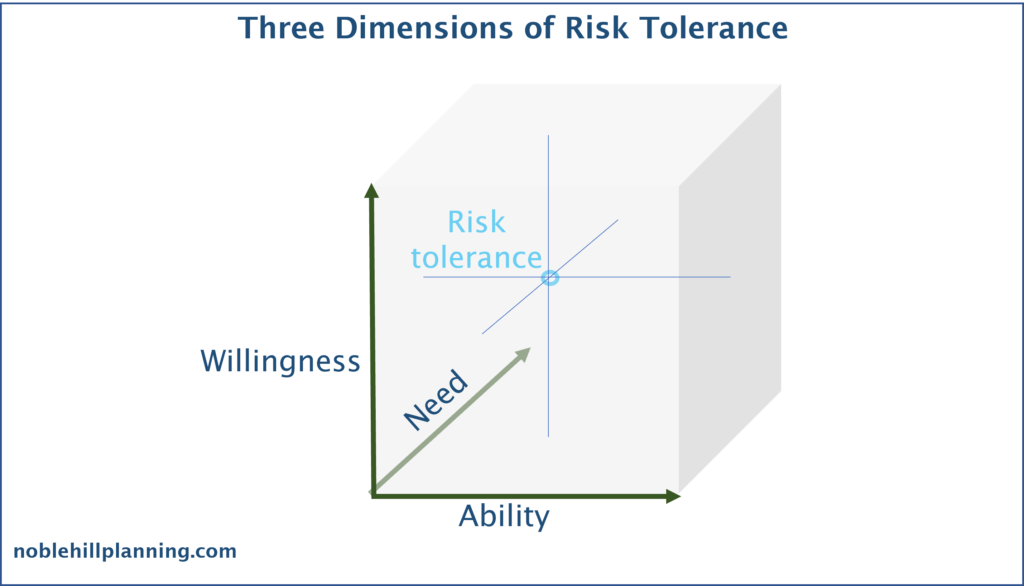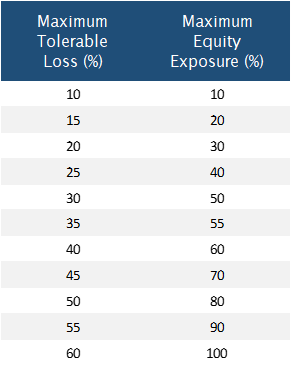Determining the proper amount of investment risk to take is a combination of art and science. You want to take enough risk to meet your financial goals, but not so much that you will crash and burn along the way.
So how can you calculate your risk tolerance? Most financial experts use a mental model that breaks risk tolerance down into three dimensions:
- Ability
- Willingness
- Need

Ability
Your ability to withstand investment risk is a function of variables such as:
- Age (very young or very old = higher risk ability)
- Current financial condition (high net worth + low debt = higher risk ability)
- Amount and security of income sources (high income + secure income = higher risk ability)
- Spending level (high spending = lower risk ability)
Generally, determining your risk ability is fairly commonsense. Here are some examples:
If you are very young (or very old), you have a high ability to take risk. If you are retiring tomorrow, then you need to think long and hard about your risk level.
If you have a very high net worth (or you’re broke), then your ability to take risk exceeds someone in the middle. In fact, if your broke, your ability to take risk is almost unbounded. After all, it can’t get much worse.
If your job is secure (i.e. you work for the government), then you can take on more investment risk than someone who works in cyclical industries.
If you need to spend 5% of your assets each year in retirement, your ability to take risk will be lower than someone who only spends 2%.
Willingness
Calculating your willingness to take risk is the most “artsy” of the three. If I ask, “How much risk you are willing to take?”, your answer will likely be influenced by the recent performance of the markets. If we were in the midst of 2008-09 or March 2020, then your willingness to take risk might have evaporated when the markets crashed. But by the end of 2020 and all throughout 2021, your willingness likely crept up each day.
This is known as recency bias. Essentially, people look at what has happened in the recent past and use that information to make decisions. Evolution has designed our brains to conserve energy when possible. And what better way to save energy than to look for the most readily available pieces of information. No need to pour through your long-term memory, we can just use what happened yesterday!
Larry Swedroe and Kevin Grogan offered a starting point to measure your willingness in their book “Your Complete Guide to a Successful & Secure Retirement.”
Start by asking yourself, “How much am I willing to lose if the stock market crashes?” Then check the table below to determine your maximum equity exposure (you can also think about it as a 1-10 scale of your risk willingness with 10 being VERY willing to take risk).

Another method involves looking at what you actually did in periods of market uncertainty. In March 2020, did you sell stocks, do nothing, or buy stocks?
- Sold stocks? Then your willingness is below average.
- Did nothing? Then your willingness is average.
- Bought stocks? Then your willingness is above average.
I urge everyone to do this exercise not from memory, but upon close inspection of account statements. Better to use hard evidence rather than recollection.
Need
How much risk do you need to take? One way to answer this question is to look at your current financial condition in relation to your financial goals. If you have $1 million in the bank today, but want to have $3 million in the bank in 20 years, you need to earn 5.65% per year to make that happen. But what if your goal was $20 million in 20 years? Well, that requires 16%+ per year.
If your required rate of return is low, then your need to take risk is low as well. But if your required rate of return is high, then you need to take on lots of risk.
What if your required rate of return is absurdly high or implausible? Make adjustments elsewhere. Can you aim for more modest financial goals? Or should you try to get a better job or start a side hustle in order to increase your income? If you are dead set on becoming a billionaire, then you’ll need to think creatively about how to get there, because it’s unlikely the stock market will get you there.
Putting it all together
Ok, so you’ve estimated your ability, willingness, and need. Now what? How can you translate them into your overall tolerance for risk? The safest path is to use the lowest of the three. For example, if you have a high ability and willingness to take risk, but a low need for risk, then your overall risk tolerance is low. After all, William Bernstein said, “When you’ve won the game, stop playing.”
But it’s important to use your best judgement here. If you need to take some moderate risk to achieve your goals, but your willingness is low, then it may be helpful to talk things over with a friend or advisor. Many people don’t take enough risk and end up in a bad position over time. They have a need, but they are not willing. If you leave all your assets in cash, then it becomes very difficult to overcome the long-term effects of inflation.
I usually recommend one of five levels of risk tolerance (Low, Medium-Low, Medium, Medium-High, High). And based on that, I use the following table as a starting point:

But everyone’s situation is different. The important thing is to think deeply about your comfort with risk as part of the financial planning process. And remember, nothing is set in stone, and your risk tolerance will change over time, so it helps to stay flexible and adapt as life changes.
Applications to life
One other nice thing about this framework is that you can apply it to almost any area of your life.
Let’s use the example of cleaning your gutters. Not exactly a risk-free activity, so should you do it yourself?
Start with ability. Does anyone depend on you and your paycheck? Do you have life, disability, and medical insurance? If not, then you should wrap yourself in bubble wrap and stay off the ladder.
Next, willingness. Do you enjoy heights? If not, then maybe pay a company to handle it.
Now for need. Can you afford to pay someone to handle it? If you can, then go ahead and do so.
Using the ability/willingness/need framework can help you think about all the dimensions of risk and come to a more effective understanding of your risk tolerance. Don’t be afraid to get creative and spend some time exploring your feelings about risk.

